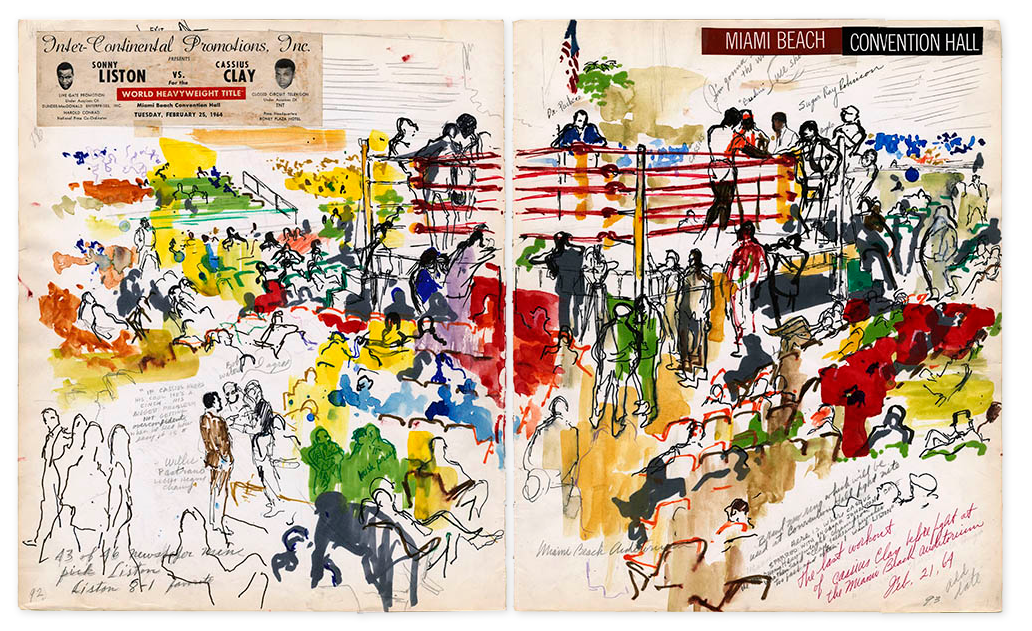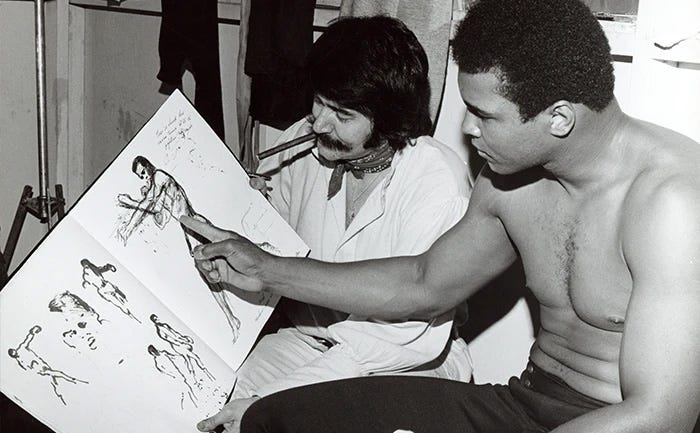Leroy Neiman: Verve and Verisimilitude
Capturing Momentous Events in Exotic Locales

I guess I was attracted not so much to Leroy Neiman’s art but to the artist’s life he lived. The dashing and jet setting personna he invented for himself, with the ear-to-ear mustache, white suits, and Cuban cigars, is one that appealed to me. LeRoy Neiman (1921-2012) always got close to the action, to celebrity and to society life.
Over the course of his successful art career he generated hundreds of paintings, drawings, watercolors and serigraph prints. Much of that work was sourced by the drawings he created on the spot.
In 1953, Neiman began his patronage by Hugh Hefner and Playboy magazine. Over the next 50 years, some of Neiman's contributions included creating the Femlin character for the Party Jokes page and the ‘Man at His Leisure’ feature, where he went on assignment to glamor spots around the world, sending back visual reportage on subjects as varied as the races at Royal Ascot, the nude beaches of the Dalmatian coast, the running of the bulls at Pamplona and Carnaby Street in swinging London.
But it was Neiman’s coverage of sporting events, like the momentous heavyweight championship prize fight in 1964 between Sonny Liston and Cassius Clay(later Muhammad Ali), where he produced his most exciting work. These early drawings display an energy and flair that his later artworks lack.
They show the young Cassius Clay as the poetry-spouting, consummate entertainer in high contrast to the scowling Sonny Liston. Neiman records Clay's taunting and trash-talking of Liston, in the gym leading up to the fights. He draws the drama and cacophony at the fight itself at the Miami Beach Convention Hall. His proximity to the action provides an intimate first person perspective that shows in his on-the-spot sketches.
It’s the energy of the moment that he captures in his drawings. Neiman worked in a sketchbook, but also on found papers, in a variety of media, adding collage elements and some nervous mark-making.

Something is lost when he retreats to his studio to paint. This was his place to disconnect. In Neiman’s obituary, The New York Times calls his expressionist paintings ‘gaudily colored visual reports.’ I’d also add that they lack the authenticity of his early work. The verisimilitude fails in comparison to the vigor and honesty of his on-the-spot drawings. Most people may not be able to tell the difference, but I do.
In previous posts I wrote about how the Morocco drawings I made by ‘being there’ differ from the one’s I made ‘working from a distance,’ using Google Street Views as reference. I realized that while the visual intent is still present in the ones drawn from photos, the difference is that they lack truth and vivacity.
LeRoy Neiman travelled the world on assignment. He knew that being present and responsive was the key to his visual journalism. While his commercial success and charismatic attitude proved to be of little interest to the art critical establishment, he lived a fearless and engaged life.
More to Know:
View Muhammad Ali, LeRoy Neiman, and the Art of Boxing at the New-York Historical Society, 2017
Here’s Neiman’s obituary in the New York Times.
Read Neiman’s bio All Told: My Art And Life Among Athletes, Playboys, Bunnies, and Provocateurs, 2012
The limited edition The LeRoy Neiman Sketchbook: 1964 Liston vs. Clay - 1965 Ali vs. Liston can be purchased at Art Brokerage for $4995.







Bill, thanks for showing this side of Leroy Neiman. I was unaware of it, and like you, I was not a fan of his work. It seemed formulaic to me and other than some of his color choices it was uninteresting. However, the examples in your story are killer and have given me a new respect for his abilities.
Those sketchbooks! I once met Ali. One of the most beautiful people I’ve ever met. So kind and gentle and authentic. Same with Johnny Cash. Maybe it was the context, but so few others had such generosity of spirit in my limited 3 hr experience of each of them. Marty Sklar too. 💗